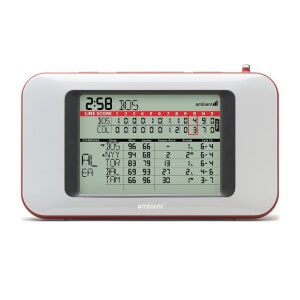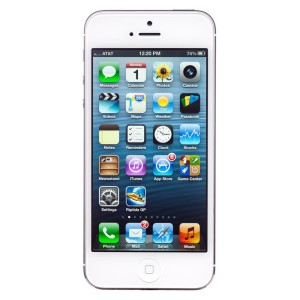Why Your Gadgets Don’t Last

I should have known it was a bad sign when I called the customer service line for a tech gadget I was thinking of buying, and the CEO answered.
It can be a good sign when a CEO answers customers’ calls — it could mean he’s highly involved in the company. But looking back on it now, I see it as a possible sign that the company doesn’t have enough workers and that its gadgets aren’t worth hiring people to promote it. I wish I would have figured that out before I bought one of the devices at Ambient, only to see the company stop offering support for it less than three years later.
It was 2011 and I was doing research for a story I was writing about energy saving gadgets when I saw the wireless devices Ambient was selling. One was called an Energy Orb that changed color when your household energy use changed.

The ScoreCast was introduced in 2008 for $125, providing baseball scores through radio signals. A wireless plan isn’t needed.
My wife and I are big baseball fans, so I thought it would be fun to have the gadget on the fireplace mantle so we could see updated scores. Believe it or not, we didn’t have smartphones in 2011, so we didn’t have the immediate access that we now do on many devices in our home.
Just for the fun of it, I decided in early April to put four new AA batteries to see if it still worked. It didn’t. While $43 wasn’t much of a loss on something that worked for two baseball seasons, I wondered why it didn’t work and I again contacted customer service. Guess who got back to me? The same guy I talked to in 2011:
“On March 1, 2014, Ambient discontinued support for the Ambient Baseball, Ambient Football & Ambient Centerfield products. As of that date, customers with these devices in their homes stopped receiving game and standings data. The Ambient ScoreCast products were introduced in 2006 and manufacturing ceased in 2009. Sincerely, Pritesh Gandhi CEO | Ambient Devices”
I emailed him back, asking him what a consumer’s expectation should be when buying a tech device. I haven’t heard back yet.
How long should a gadget last?
Ambient’s pulling the plug got me wondering what consumers should expect when buying a tech gadget. Will the startup company that you were so fond of be around seven years from now when your device dies or needs tech support?
Is it just part of the expectation of a disposable society that when a relatively inexpensive gadget stops working, you’ll trade it in for a new one, recycle it, or worst-case, throw it away?
Or does the joy of helping a startup get going through a Kickstarter campaign outweigh any money you’ve spent on a product that doesn’t last long?
I’ve had a few experiences lately with startups and their gadgets. One worked out great with the Waka Waka solar lights working exactly as advertised. Another gadget, a portable WiFi device called Karma Go is still up in the air and delivery has been delayed a few times. I’m anxiously awaiting its arrival, and hope it will still be around in seven years.
The disposable phone

Like many people, I’ve owned way too many phones over the years. Each has lasted about two years before I’ve either upgraded to a new one while the old one was still working, or it died a slow death and I needed to buy a new one.
I’ve been happy with the iPhone 4 that I’ve had for about two years, but too many new apps don’t work on it, leaving me jonesing for an iPhone 6.
The high cost has put me off. As someone who likes to run things into the ground until they die — I owned a car for 23 years before buying a used car last year — I expect things to last. But with a smartphone, I’ve come around to accepting that updated software, if nothing else, will make the latest phone seem ancient in a few years.
A recycler’s view
Phil Gibbs, director of Pure Planet Recycling Limited, an electrical waste recycling in the United Kingdom, told me in an email that he thinks three to five years is a realistic expectation for consumers who want their tech gadgets to last or be supported.
“If tech was built to last, didn’t scratch easily or didn’t have the support on the device we wouldn’t be so inclined to upgrade or update our tech,” Gibbs says.
Shelf life differs among gadgets, with a phone, tablet or handheld gadget expected to last around three years, he estimates. That includes tech support. Buying from a known brand is key, Gibbs says, while a startup should have a lower price for its gadgets and a lower expectation.
“Home technology and gadgets seem to be made of less durable materials to keep manufacturing costs down,” he says. “This can be seen in the material value of equipment now when recycled versus older electrical components.”
An entrepreneur’s view
While every startup wants to be around decades, if not forever, longevity requires being profitable in a growing market, says Jackie Wu, a Northwestern University grad student who has a Kickstarter campaign for an indoor flying security camera he’s working on with others.
Without that growth, businesses can’t afford to support their products for years and years, Wu told me in a phone interview.
Early adopters of gadgets are willing to gamble and will support a flying smartcamera with a $200 purchase, Wu says, but others may want to wait until the product is more established. Drones are a growing field, he says, and the product, also called “Jackie,” should last years.
Wu doesn’t expect the Jackie to break often, though running it into walls too often could cause the weakest part — the propellers — to break. But those are inexpensive and easy to fix, so the company could mail replacements to customers to put back on themselves, he says. And because the camera syncs to a user’s phone, software updates will be sent through the phone — another inexpensive way to keep it running.
Any high costs for the business, however, could lead to problems if it isn’t growing fast enough. Wu’s company provides cloud storage for users, which gets expensive, he says.
Just like any other consumer, Wu, 24, knows first-hand how long tech gadgets last when compared to his expectations.
Wu says he buys a $500-$600 Android phone every year or so because they always break. It’s a frustrating purchase, even for a phone that is supposed to be a top-of-the-line product at the time of purchase.
“They make these things to fail in one to two years so you buy a new one,” Wu says.
Coming from a tech entrepreneur who wants consumers to buy his product and trust that it will be supported for years to come, it’s comforting to know that he’s seen both sides of the gadget life issue and will hopefully keep his customers in mind when making customer support decisions.





